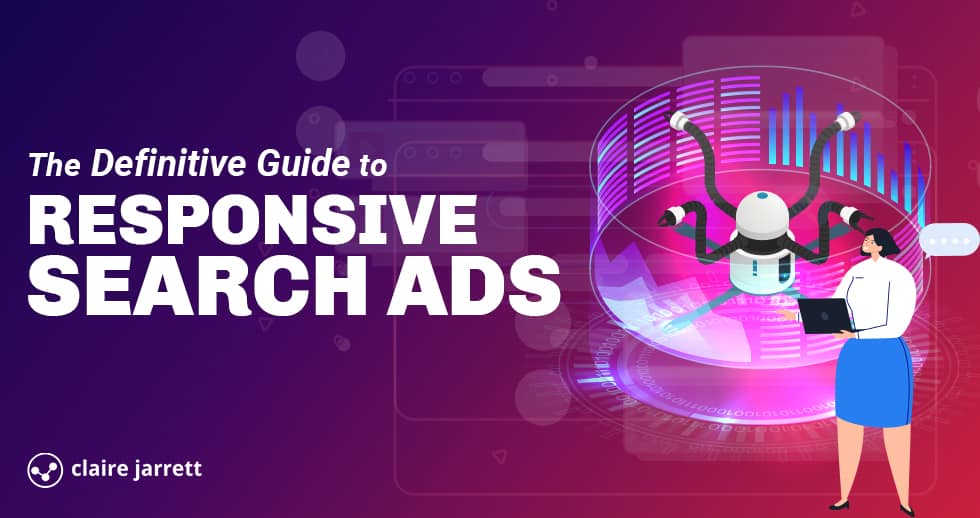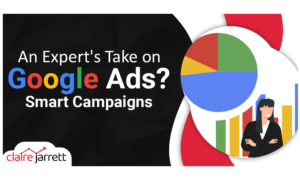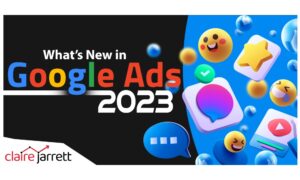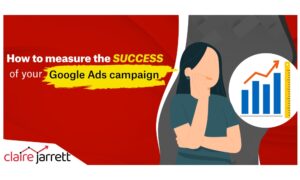The Definitive Guide to Responsive Search Ads

Last Updated on: 27th February 2025, 07:31 pm
You can’t please everyone. No matter what ad campaign you launch, there’s bound to be someone in your audience who doesn’t like it, right? Actually – no. With Google’s responsive search ads (RSA), you can genuinely please everyone in your audience.
All it takes is the right combination.
No matter if you’re new to responsive search ads, an expert, or you came here because Google has stopped supporting expanded text ads, I’m going to show you everything you need to know about responsive search ads.
Let’s dive in!
What Are Responsive Search Ads and How Do They Work?
One of your leads is looking for convenience. Another is looking for a fast turnaround. A third wants both – plus competitive pricing.
Before RSAs, covering all these angles meant writing multiple ads, setting up A/B tests, and hoping your best guess at messaging resonated with the right person. Even then, you’d waste ad spend serving the wrong message to the wrong person at the wrong time.
That’s no longer the case. RSAs automatically mix and match multiple headlines and descriptions to deliver the most relevant message based on the searcher’s intent.
So, for example:
- If one lead is looking for a convenient service, Google might show ad copy highlighting your fast, hassle-free process.
- If another is more price-conscious, the AI might emphasise your rates or discounts they won’t get from your competitors.
Over time, the system learns which messages perform best and adjusts accordingly. Endless combinations offer endless opportunities to match the searcher’s intent and convert leads into paying customers!
“But Claire, how does Google decide which ad to show?”
Glad you asked. RSAs are built on three steps:
- Understanding search intent. Google analyses the query and matches it to keywords in your campaign.
- Assembling ad combinations. The system selects relevant headlines and descriptions based on expected performance.
- Filtering and ranking. It removes duplicate or redundant combinations and serves the highest-scoring version in the ad auction.
The more search volume your campaign gets, the faster Google learns which ad combinations work best. Some assets might rarely appear if Google determines they only resonate with a small subset of searchers. That doesn’t mean they’re ineffective, though, just that they serve in specific contexts rather than across all searches.
Plus, when your ad text closely matches a user’s search query, Google may automatically bold it to increase relevance and click-through rates.
The Lego Blocks of Your Ads: Ad Strength and Character Limits
When setting up RSAs, keep in mind the following character limits:
- Headlines: Up to 30 characters (max 15 headlines per ad).
- Descriptions: Up to 90 characters (max 4 descriptions per ad).
- Path fields: Up to 15 characters each (used for display URLs).
(And yes, double-width languages like Japanese, Korean, or Chinese count each character as two.)
Lego-Blocking It: Responsive Search Ads in Practice
The foundation of RSAs is variety. While they’re similar to ETAs in appearance, they allow you to create multiple headlines and descriptions.
In every ad, Google will select up to 3 headlines and 2 descriptions to display to searchers, based on their behaviour and preferences. Over time, the AI will find the best-performing ad combinations.
For example, with the predecessors, ETAs, you’d create an ad with specific copy:
“Business coaching course
Learn everything you need to increase your sales! 20% discount available for startups.
Claim your offer today”
This ad would isolate a lot of your audience members. What if someone isn’t looking to increase sales but improve their team productivity? What if they’re not a startup and can’t avail the discount?
With responsive search ads, your setup would look like this:
Headline options:
- Business coaching course for managers
- Improve your team’s productivity with a coaching programme
- Designed to drive results
- Business course used by Fortune 500 companies
Description options:
- Improve your results and improve your business with a super-powered course. Custom plans available for enterprises.
- Better results, better business! Now offering 20% off to startups.
Depending on the searcher, Google’s AI would choose the best combination. For example, startups may see:
“Improve your team’s productivity with a coaching programme | Designed to drive results
Better results, better business! Now offering 20% off to startups.”
And enterprises might see:
“Business course used by Fortune 500 companies | Business coaching course for managers
Improve your results and improve your business with a super-powered course. Custom plans available for enterprises!”
Responsive Search Ads vs Extended Text Ads
Up until 2017, Google Ads was called AdWords, and there was only one type of search ad: standard text ads. Unlike responsive search ads or even expanded text ads, standard text ads offered only one headline and 2 description lines, with a total of 95 characters.
Once they were replaced with expanded text ads, advertisers could add more ad extensions, explain their offer in 140 characters, and include two headlines. All of this is long gone. RSAs replaced expanded text ads as the default search ad type in 2022. And that was a good thing – searchers love RSAs!
Plus, the Search is changing and evolving; Google Ads have to, too.
Key Differences Between Extended Text Ads and Responsive Search Ads
| Responsive Search Ads | Extended Text Ads | |
| Headlines | Up to 15 | Up to 3 |
| Descriptions | Up to 4 | Up to 2 |
| Maximum ad length | 300 characters | 150 characters |
| Control | Low | Complete |
With extended text ads, you had complete control over your ads. But with responsive search ads, Google Ads drives the performance forward with its machine learning capabilities. This doesn’t mean your ad campaigns will run on autopilot, as there is still a lot of work to do with keyword research, ad creation, and optimisation.
However, responsive ads do make it easier to cover more ground within a single ad group.
How Do Responsive Search Ads Work?
The foundation of responsive search ads is variety. While they’re similar to expanded ads in appearance, they allow you to create multiple headlines and descriptions.
In every ad, Google will select up to 3 headlines and 2 descriptions to display to searchers, based on their behaviour and preferences. Over time, the AI will find the best performing ad combinations.
For example, with expanded text ads, you’d create an ad with specific copy:
Business coaching course
Learn everything you need to increase your sales! 20% discount available for startups.
Claim your offer today
This ad would isolate a lot of your audience members. What if someone isn’t looking to increase sales but improve their team productivity? What if they’re not a startup and can’t avail the discount?
With responsive search ads, your set-up would look like this:
Headline options:
- Business coaching course for managers
- Improve your team’s productivity with a coaching programme
- Designed to drive results
- Business course used by Fortune 500 companies
Description options:
- Improve your results and improve your business with a super-powered course. Custom plans available for enterprises.
- Better results, better business! Now offering 20% off to startups.
Depending on the searcher, Google’s AI would choose the best combination. For example, startups may see:
Improve your team’s productivity with a coaching programme | Designed to drive results
Better results, better business! Now offering 20% off to startups.
And enterprises might see:
Business course used by Fortune 500 companies | Business coaching course for managers
Improve your results and improve your business with a super-powered course. Custom plans available for enterprises!
In some cases, Google Ads might only use 1 RSA headline or use the headline within the description copy.
Keep in mind that all the options have to make sense when combined.
You don’t want to have an option that only mentions a discount without explaining what it is that you do.
Can You Use Only One Headline in RSAs?
Yes! Since February 2024, Responsive Search Ads have started supporting only one headline in the ad – where it makes sense (i.e., is predicted to improve performance). However, if you pinned a headline, you might still have two displayed, so I recommend removing the pin.
If there’s no way for you to create all the assets without repeating yourself, I’ll show you a way to make sure specific copy appears in your ad. Read on!
New Elements of Responsive Search Ads
The staples of search ads haven’t changed much; there’s still copy to write and keywords to target. However, Google’s added a few things to the toolbox:
Ad Strength
Whenever you create or analyse the performance of a responsive search ad, you’ll see the Ad Strength indicator. This is Google’s predictive take on how well your ad is structured. While it’s not a direct ranking factor in the auction, it’s a guidance system for better performance.
You’ll see specific suggestions such as:
- Headlines/Descriptions that are too similar
- When to add popular keywords to your descriptions
- You’ll also see suggestions for assets, as well as specific ideas on how to improve.
By the Way: It’s Important to Separate Ad Strength from Quality Score
Your Quality Score is a diagnostic tool that measures historical performance based on expected CTR, ad relevance, and landing page experience.
Ad Strength, on the other hand, is a forward-looking metric designed to help you create stronger, more adaptable ads. It updates in real time as you build or edit your RSA, offering specific recommendations for improvement.
Before you get worried, Ad Strength doesn’t directly affect your bidding and CPC. Of course, if the AI is right and your ad isn’t up to par, you’ll feel it eventually.
What Does Ad Strength Measure?
Google rates your RSAs on a four-tier scale:
- Poor
- Average
- Good
- Excellent
Your rating depends on four key factors:
- Number of headlines
- Uniqueness of headlines
- Keyword relevance
- Uniqueness of descriptions
Google isn’t the authority on your brand voice, but it does have access to a massive amount of data on what converts.
According to Google, advertisers who improve their Ad Strength from “Poor” to “Excellent” see, on average, 12% more conversions. Plus, KFC Malaysia saw a 40% order increase from their Google Ads campaigns after integrating Ad Strength suggestions. So it’s worth paying attention.
How to Improve Ad Strength (Without Compromising Strategy)
Here’s how to boost your score while keeping control:
- Don’t just hit the headline minimum. Go for at least 10-15 variations. Even small tweaks (“Free Consultation” vs. “Book Your Free Consultation”) add valuable diversity.
- Write distinct descriptions. Google won’t reward you for rewording the same message three times. Focus on different angles like benefits, trust signals, incentives…
- Use strong, relevant keywords, but naturally. Stuffing every headline with the same Main Keyword + Generic Phrase approach isn’t the way to go.
Test automatically created assets. I know, AI-generated ad copy can be a mixed bag, but sometimes it provides fresh perspectives you wouldn’t have thought of.
Pinning
By default, Google mixes and matches your headlines and descriptions. But sometimes, there are non-negotiables, like messages you always need to appear no matter what.
Pinning lets you lock specific headlines or descriptions into fixed positions, so that they show up every time your ad is served. This is particularly useful for:
- Legal disclaimers (e.g., required compliance text).
- CTAs (because an ad without a clear call-to-action is wasted ad spend).
- Discounts and special offers (especially if they’re time-sensitive and critical to the ad’s effectiveness).
For example, if your industry requires a regulatory disclaimer, you can pin it to Description position 1, guaranteeing it’s always visible.
The Downsides of Pinning (and How to Avoid Them)
Pinning sounds simple enough, but overusing it can backfire. If you lock in too many elements, Google has fewer ad variations to test, which hurts performance and lowers your Ad Strength score.
Here’s what to watch out for:
- If you pin a single headline to Headline 1, it will always appear there, meaning other headlines never get tested. A better approach is to pin multiple options. Instead of locking in just one, pin two or three to the same position so Google can rotate them and find the best performer.
Example:
- Bad pinning: Pinning only “Official Website” to Headline 1 means it always appears, restricting variation.
- Better pinning: Pinning “Official Website” AND “The Official Site” to Headline 1 lets both rotate and see which performs better.
Some pinned elements aren’t guaranteed to show – If you pin a headline to Headline 3 or a description to Description 2, they may not always appear, depending on ad placement and space.
If something is critical, pin it to Headline 1, Headline 2, or Description 1 instead.
Account-Level Automated Assets in Responsive Search Ads
Google’s AI progress means RSAs now include account-level automated assets. Google can generate things like sitelinks, callouts, and structured snippets without you having to add them manually.
It can help you with:
- Dynamic images (e.g., it can pull images from your landing pages and insert them into your ads even if you didn’t upload them)
- Dynamic sitelinks (e.g., if the AI realises your ad would perform better if it linked to a page on your website, it might add it)
- Dynamic callouts (e.g., AI might spot a new offer on your landing page and syndicate it as a callout)
- Dynamic structured snippets (e.g., AI wants to emphasise specific parts of your offer)
While this might sound great, here’s what else you need to know:
- Google can now pull additional elements from your website (or past ad performance) and insert them dynamically.
- You can review & disable automated assets at the account level if you prefer full control.
- These auto-generated assets are designed to boost relevance, but they might not always align with your messaging. Always review what’s appearing in your ads!
If you’re running RSAs with automated assets enabled, check your account-level settings periodically to make sure Google’s AI isn’t pulling something off-brand or outdated.
Advantages of Responsive Search Ads
One of the biggest perks of responsive search ads (RSAs) is that they get more eyeballs, and not just because Google is pushing them as the default ad type. They show up more often because they’re simply more relevant.
Instead of forcing a single ad to work for every searcher, RSAs dynamically adjust to match what people actually care about.
These ads dynamically adjust to different device widths, so your ad is harder to ignore. If you could capture attention and drive conversions in 150 characters, imagine what you can do with 300!
And since you can add up to 15 headlines and 4 descriptions, that’s a huge number of possible ad variations – over 40,000 combinations if you max out your assets. So, if your old expanded text ads weren’t appearing for certain queries, RSAs fill in the gaps and help your business compete in searches you were missing before.
And when your ad is more relevant, good things happen. You get higher CTRs and more engagement. Google rewards those with lower CPCs and, of course, stronger Quality Scores, helping you compete in more auctions without overpaying.
Finally, optimisation is the key to Google Ads success. With RSA, you can benefit from AI’s seemingly endless ways to analyse your results. Of course, I always recommend taking AI with a grain of salt and doing the analysis yourself, but it doesn’t hurt to listen to suggestions.
Disadvantages of Responsive Search Ads
While I think responsive search ads are a fantastic tool to increase your conversion rate, there are some drawbacks. Namely, you have less control.
As in the examples above, you can’t simply write copy, create multiple ads, and then put them to work and testing.
Instead, you only enter the options, and Google will generate combinations interesting to searchers. I think this isn’t necessarily negative as it opens up more room for optimisation and gathering audience insights, but if you struggle to relinquish and reallocate control to other aspects of your Google Ads account, beware.
Secondly, if you want to make sure certain elements appear in every combination, you can’t try and cheat your way to traditional ads by pinning everything. There is a firm limitation; you can only pin a few elements. Keep in mind that, by pinning, you are reducing the possible combinations Google can show to searchers. Use it sparingly.
Finally, avoid repetition and make your copy options unique. This can be challenging, but you don’t have to use all the available characters or asset slots. You can start your campaign with only a few options and then expand as you get more insights.
Ultimately, responsive search ads are a powerful tool. However, it’s essential to leverage them properly.
How to Create or Edit Responsive Search Ads
The process of creating RSA is straightforward:
- Log into Google Ads and open your campaign dashboard.
- Click the Campaigns icon, then select your campaign.
- In the left-hand menu, click Ads & Assets, then go to Ads.
- Click the + button, then select Responsive Search Ad.
- Enter your final URL – this is where people land after clicking your ad, so make sure it matches the intent of your messaging.
- Set your display path (optional but great for reinforcing relevance).
- Add your headlines (at least 3, up to 15). Google will rotate these, so each should stand alone and make sense in any combination.
- Write your descriptions (at least 2, up to 4). Google will show up to two at a time.
- Check the ad preview on the right panel. Not every combination will show up, and Google might shorten some lines, so don’t rely on the preview alone.
- Click “Save”, and your RSA will start running with Google automatically testing combinations to find the best performers.
How to Edit a Responsive Search Ad
- Go to Ads & Assets inside your campaign.
- Click Ads, then apply a filter to find Responsive Search Ads.
- Hover over the ad you want to update and click the pencil icon to edit.
- Update your headlines, descriptions, or URLs, but be aware that major changes can reset Google’s learning phase.
- Click Save, then check the Ad Strength indicator to see if your changes helped or hurt performance.
Here’s a tip: If an ad is already performing well, don’t eliminate it entirely. Make small, strategic tweaks instead of a full rewrite. This way, you keep the momentum while improving results.
Analysing Your Responsive Search Ads Performance
If you’re used to expanded text ads, where you could easily track performance at the ad level, RSAs can feel…weird.
When you go to review performance, what do you get? Impressions.
And while impressions tell you how often an asset appears, they don’t tell you why or how those variations contributed to conversions. That’s why you should use Google’s Ad Strength, Asset Reports, and Performance Ratings come in.
If you know how to use them properly, they can help you refine your RSAs for better clicks, better conversions, and ultimately, better results.
Understanding Google’s RSA Asset Report
The RSA Asset Report gives you a qualitative view of how Google evaluates your headlines and descriptions.
You won’t see exact conversion data per asset, but you’ll get ratings like “Best”, “Good”, and “Low”, based on how each asset performs relative to others in your ad.
Here’s what these ratings mean:
- Best: One of your highest-performing assets –consider adding more like it.
- Good: Performing well, but could use supporting variations to improve results.
- Low: Not pulling its weight – replace it with a stronger variation.
- Learning: Google is still collecting data before assigning a rating.
- Pending: No performance data yet. Hold your horses.
If you see too many “Low” ratings, it’s a sign that some of your headlines or descriptions aren’t clicking with your audience. Try swapping them out for fresh variations, especially ones that match search intent more closely.
Where to Find the RSA Asset Report
- Sign into your Google Ads account.
- Click the Campaigns icon.
- In the menu, select Ads.
- Find the Responsive Search Ad you want to analyse.
- Click View Asset Details at the bottom.
This will bring up the ad-level asset report, where you can review performance ratings, impression data, and asset details.
What About Clicks, Conversions, and Revenue?
Now, RSAs don’t give you direct asset-by-asset conversion tracking. You’ll see which combinations appear most frequently, but Google isn’t going to break down the conversion impact for each variation.
Does this mean asset reports are useless? No! but you need to interpret them correctly.
Let’s say you update your RSAs, and suddenly:
- Impressions increase, but CTR drops. This could mean Google is testing more combinations, so click behaviour might fluctuate before settling.
- CTR rises, but conversions stay flat. Your ad is catching more attention, but you might not be driving the right audience to convert.
- Conversions increase, even if CTR dips. This is a win! More qualified users are clicking, even if fewer people overall engage with the ad.
As I always say, conversions matter more than clicks. If you’re making RSA changes, track how they impact actual leads and sales, not just surface-level engagement.
Using RSA Performance Data to Improve Your Ads
- Look beyond individual assets – If one headline gets fewer impressions, it doesn’t mean it’s bad, it just might be more situationally relevant. Keep a mix of broad and niche headlines.
- Don’t just remove “Low” performers but replace them – Google recommends swapping out weak assets, but don’t just delete them. Test alternatives to see what resonates.
- A/B test your ad variations strategically – Instead of blindly swapping assets, run structured tests using Google’s Ad Variations tool to see what actually improves performance.
- Be patient with Learning Mode – If a new headline or description is still in “Learning”, let it run for at least 2,000 impressions before making judgment calls.
Instead of obsessing over individual asset performance, focus on business impact:
- Are more people converting?
- Is your cost per lead going down?
- Are you reaching a better audience?
If the answer is yes, you’re on the right track. If not, it’s time to analyse, test, and refine.
Combinations Report
Google’s Combinations Report is the tab located right beside the Asset Report.
It gives you a behind-the-scenes look at how your responsive search ads are being assembled and which variations are appearing most often.
Again, it doesn’t tell you exactly which headline or description is driving conversions, but does it help you understand which combinations are winning the most impressions. This is valuable because impressions give you insight into what Google’s AI considers “most relevant” for different searches (but that doesn’t mean you should blindly trust it).
How to Use the Combinations Report (Without Misinterpreting It)
When you pull up your Combinations Report, you’ll see:
- The different ad variations Google has been serving.
- Their impression share (how often each combination appears).
At first glance, it might seem obvious: “The most-shown combination must be the best, right?”
Not necessarily.
Impressions aren’t synonymous with conversions. Just because a combination gets the most visibility doesn’t mean it’s converting well.
A high-impression, low-conversion ad could be wasting a ton of your budget.
Plus, some search terms naturally get more volume than others. If your most-seen ad is attached to high-traffic, low-intent searches, those extra impressions may not be worth much.
How to Actually Improve Google Ads RSA Performance with Combinations Data
So, how do you use this report without falling into the “more impressions = better” trap?
- Compare it with your Asset Report – If a combination gets high impressions but contains underperforming assets, you may need to tweak your messaging.
- Check your conversion data separately – Are your high-impression combinations actually bringing in leads, or just driving traffic that bounces?
- Test strategic pinning (sparingly) – If an important CTA or offer isn’t showing often enough, you might consider pinning it in place. But don’t overdo it, or you’ll limit Google’s ability to optimise.
Look for patterns in high-performing combos – If you notice that certain types of messaging keep appearing in your best combinations, lean into those themes when writing new assets.
Best Practices for Responsive Search Ads: Ad Creation
Keyword Mix in the RSA Era
While it’s tempting to think you can now target every keyword under the sun, particularly if you’re using Dynamic Keyword Insertion, you still have to do your research.
Don’t focus solely on generic, broad keywords. Instead, use the fact you can create different ad groups to prepare mixes of relevant keywords for each audience segment or even experiment with the Single Keyword Ad Group approach. Address different pain points and specifics.
Keywords can also be a great starting point for your ad copy. They give unfettered access to your audience’s needs. From there, you simply have to connect them with specific benefits and solutions that your product or service provides.
If you’re not using relevant keywords or not using them enough, Ad Strength will remind you of it.
One At a Time, Please!
Avoid the temptation to create multiple responsive search ads in every ad group. This prevents Google from doing what it does best: experimenting and learning.
It’ll be much harder for the AI to optimise your ads. Stick to one responsive search ad per ad group and keep everything neat.
Remember that you can only add one link to your landing page. Don’t try to address multiple audience segments with fundamentally different needs and characteristics.
For example, if someone is searching for your business because they’re interested in booking a massage, you don’t want an option to pop up offering nail extensions.
Separate your responsive search ads according to target demographics and intents.
Leverage Ad Assets with RSA
Ad assets expand your ad’s visibility, give searchers more reasons to click, and provide extra context about your business. But the “secret” here is choosing assets strategically, not just enabling every option.
Here’s what you should focus on:
- Business Name & Logo: Reinforce brand credibility at a glance. If you haven’t set these up yet, do it now. Otherwise, Google might auto-select them for you.
- Sitelinks: Direct users to specific pages (pricing, testimonials, free trial sign-up, etc.), helping them find what they need faster.
- Call Assets: A staple if your business thrives on phone leads. They make it easy for potential customers to call you straight from the ad.
- Location Assets: Crucial for local businesses like plumbing businesses. If you rely on foot traffic, linking to Google Business Profile and showing your store’s address can increase walk-ins and calls.
- Price Assets: Show upfront pricing to prequalify leads. If cost transparency is a selling point, this asset is the one. If the price is right, your ads will stand out with their transparency and propel your leads down your conversion funnel.
- Promotion Assets: Running a sale? Highlight time-sensitive offers directly in your ads. These are great for seasonal campaigns or limited-time discounts.
- Lead Form Assets: If your goal is lead generation, these let users submit inquiries directly from the ad without even visiting your website.
- App Assets: Promote app downloads straight from your ad. Ideal for businesses with mobile apps as a core part of their service.
Google recommends using all available assets that make sense for your business to maximise ad effectiveness. Just because an asset is available doesn’t mean you should use it, though. If a certain asset doesn’t add value to your offer, skip it.
For local businesses and immediate needs (for example, searching for a locksmith), I’ve found call assets to work particularly well.
However, if your customers still need to be educated before finally converting, use descriptive site link assets to link to other valuable resources.
Best Practices for Responsive Search Ads: Ad Copy
Avoid Repetition
The point of responsive search ads is variety; every searcher should see something that resonates with them. If you’re tempted to repeat the same value proposition in multiple headlines or descriptions, stop.
How would you feel if someone kept repeating they were punctual across their ads? Personally, I’d feel as though they’re lacking credibility.
Try Different Headlines
When writing your Google Ads copy, try different headlines. Experiment with lengths, omitting keywords, using keyword variations, and leveraging Dynamic Keyword Insertion.
While keyword-stuffing your ads is never a good idea, you don’t want to send leads in a different direction because they can’t relate to how you phrased their need. Use your audience’s words.
I’d recommend you start with three strong headlines as your foundation. If Google only picks three, they should make sense together and communicate your core message. From there, you can expand with more variations.
Test Different Descriptions
If all your descriptions sound the same, it’s time to experiment! Google may show 2 descriptions at the same time, so make sure they’re not repetitive and emphasise different value propositions.
Even though responsive search ads are a different search ad format, the golden rule of search copy still stands: it’s not about you. It’s about your audience.
Focus on Benefits
With so many options for headlines and descriptions, it’s easy to fall into a slump and start rewording your copy. Don’t do it.
If you enter too many similar suggestions, Google won’t be able to mix and match different elements, and you won’t be experiencing the real benefits of responsive search ads.
Keep your combinations unique.
CTAs
Another element that you can play with is your call-to-action copy. Again, make sure your CTAs are visible in every combination.
Then, try out different options and see which ones resonate with your audience:
- Learn more
- Book now
- Get started
- Claim your discount
Incentives
You can experiment with different types of incentives, as well.
Some searchers may respond best to urgency. Others may click because you’re offering them a discount. There are plenty of ways to capture that conversion if you’re using responsive search ads.
For example, a small business may create two CTAs: one with a limited offer and another with a discount. A tech company could reach out to both small businesses and enterprises by offering a discount for smaller businesses and custom plans for enterprises.

Reinforce or Remind
Responsive search ads are the perfect opportunity to experiment with different sentiments.
- For example, one lead may respond well to hearing about their pain points (e.g. “Stop wasting time!”).
- Others may prefer to step closer to achieving their goals (e.g. “Win back your time!”).
- Of course, a neutral headline may work as well (e.g. “The easiest time management tool!”).
All the tricks in your ad creation book still work. It’s only the format that has changed.
What About Your Brand?
Finally, showcase your personality.
Often, with responsive search ads, your ads can start to sound and look a lot like your competitors due to all the possible combinations Google can display.
If you want to make sure your branding comes across in your ad campaigns, as well, make sure as many assets as possible highlight what makes you unique.
More of this, please:

Landing Page Optimisation
If your ads are now hyper-personalised, your landing pages have to be relevant to your lead’s intent and your ad, too.
Google’s AI pays close attention to your landing page. If there’s a disconnect between what your ad says and what’s actually on the page, Google may downgrade your ad performance over time.
For example, if your ad promotes “50% off annual plans,” but your landing page barely mentions the discount, you’ve just created friction. Searchers should land on a page that reinforces what they just clicked on, making it easy to convert.
By the way, if a certain headline in your RSA gets the most impressions, that means Google sees it as highly relevant. Leverage that insight!
If searchers respond well to a particular phrasing, mirror that messaging on your landing page. On the flip side, if an asset isn’t getting any traction in your ad, and it’s featured heavily on your landing page, consider revising that section.
In some cases, you may need different campaigns to keep everything clean and avoid directing bank managers to landing pages on personal finance. But in others, you simply need to make sure that the value propositions you’ve mentioned in your assets appear on your landing page.
How to Work with an AI-Ready Account Structure
Google’s recommendation for getting the most out of Search ads is full AI integration, meaning Smart Bidding, broad match, and RSAs working together.
At a glance, it makes sense. Smart Bidding optimises for conversions, broad match expands reach, and RSAs dynamically test creative variations. When used correctly, this trio can help Google serve the right ad to the right person at the right price. At least, in theory.
But before you go all in, let’s talk about strategy.
Forget outdated campaign segmentation based on hyper-specific match types. Instead, group keywords by shared budget and performance target.
If multiple keywords are aiming for the same goal (like lead generation or e-commerce sales), they shouldn’t be siloed into separate campaigns.
Keep in mind that the more data you consolidate into similarly themed groups, the better AI can optimise. This doesn’t mean you should throw all caution to the wind and let Google run the show. It means that account structure should serve business objectives first, and simplify where it makes sense.
Endless Combinations, Endless Ways to Convert Your Leads
While I’ll miss expanded text ads, there’s no doubt that responsive search ads are a fantastic way to get even better results from Google Ads.
After all, with over 43,000 possible combinations, there are numerous ways to make responsive search ads the best tool in your advertising toolbox.
Want to make the most of responsive search ads? My team and I would love to help! Book a call today!
Ready to take the reins? Achieve rapid Google Ads success in 7 easy steps with your copy of my best-selling Google Ads book!




















One Comment